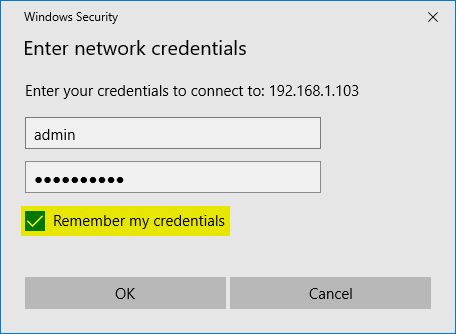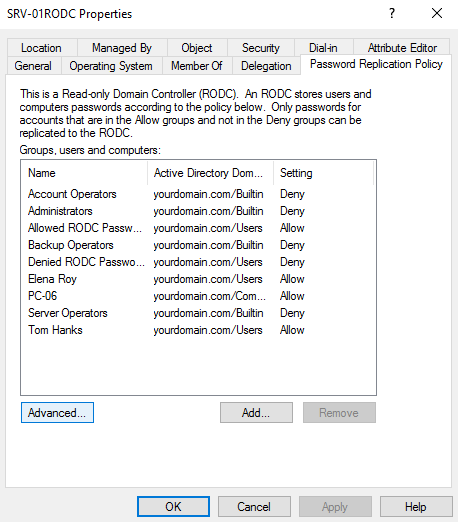
Are the domain components of the Search Base correct?. Did the user type the correct credentials in the authentication text boxes?. If the Searching User text boxes are empty: If you receive this error, look at your Active Directory server settings and make sure you have configured the Search Base and DN of Searching User text boxes correctly. If the values are incomplete or incorrect, the Bind request fails and you see the LDAP binding not successful message in your log files. #MAC OS ACTIVE DIRECTORY PASSWORD CACHE FULL#
For the Bind to be successful, the full and correct Distinguished Name (DN) or Searching User UPN must appear in the DN of Searching User text box. If the Search Base text boxes contain values, Fireware uses them for the first Bind.
 The values of all DC= components used for the Search Base when you configure the Active Directory Primary Server Settingsįor example, if the Search Base is OU=salespeople,OU=corp,OU=seattle,DC=seattle,DC=mywatchguard,DC=com and the user tries to authenticate with the username bsmith, Fireware attempts the first Bind with the username. To construct the user's UPN, Fireware puts these values together in one string: If these text boxes are empty, Fireware sends the first Bind request with the user principal name (UPN) form of the user name, which is usually the same as the user's email address. If you add credentials in the DN of Searching User and Password of Searching User text boxes, Fireware uses these credentials for the first Bind to establish permission to access the directory service. If the first Bind fails, the second Bind does not occur. The second Bind verifies the user credentials in the directory. The first Bind establishes permission to access the directory service. When a user authenticates, Fireware sends two Bind requests to the Active Directory server: one at the start of the authentication process and one at the end. Policy Manager Active Directory Authentication Server Settings If you have problems with user authentication through your Active Directory server and find the message LDAP binding not successful in your log messages, there is likely either an error in your Active Directory server settings, or an error in the Active Directory user account information. How can I fix permis… on 10.Resolve a Bind Error in Active Directory Authentication Configuring System Integrity Protection in a NetBoot environmentĪ process called sdm… on Server.app 5.0.4, sdmd, and…. Add `product id` to a distribution pkg with Packages.app. Log out of the admin account and now the user can log in as themselves off-site using their AD credentials and access the already created home directory in /Users/. Step 5 recreates the cached user information in /var/db/dslocal/nodes/Default/users/.plist (as long as the computer can talk to Active Directory), but this time with a cached password. I had the user type their password to match their AD account. I then issued sudo /System/Library/CoreServices/ManagedClient.app/Contents/Resources/createmobileaccount -n -p . This removes the locally cached information for the user from /var/db/dslocal/nodes/Default/users/.plist but leaves the /Users/ home folder data alone. I removed the current cached user info, sans password with sudo dscl.
The values of all DC= components used for the Search Base when you configure the Active Directory Primary Server Settingsįor example, if the Search Base is OU=salespeople,OU=corp,OU=seattle,DC=seattle,DC=mywatchguard,DC=com and the user tries to authenticate with the username bsmith, Fireware attempts the first Bind with the username. To construct the user's UPN, Fireware puts these values together in one string: If these text boxes are empty, Fireware sends the first Bind request with the user principal name (UPN) form of the user name, which is usually the same as the user's email address. If you add credentials in the DN of Searching User and Password of Searching User text boxes, Fireware uses these credentials for the first Bind to establish permission to access the directory service. If the first Bind fails, the second Bind does not occur. The second Bind verifies the user credentials in the directory. The first Bind establishes permission to access the directory service. When a user authenticates, Fireware sends two Bind requests to the Active Directory server: one at the start of the authentication process and one at the end. Policy Manager Active Directory Authentication Server Settings If you have problems with user authentication through your Active Directory server and find the message LDAP binding not successful in your log messages, there is likely either an error in your Active Directory server settings, or an error in the Active Directory user account information. How can I fix permis… on 10.Resolve a Bind Error in Active Directory Authentication Configuring System Integrity Protection in a NetBoot environmentĪ process called sdm… on Server.app 5.0.4, sdmd, and…. Add `product id` to a distribution pkg with Packages.app. Log out of the admin account and now the user can log in as themselves off-site using their AD credentials and access the already created home directory in /Users/. Step 5 recreates the cached user information in /var/db/dslocal/nodes/Default/users/.plist (as long as the computer can talk to Active Directory), but this time with a cached password. I had the user type their password to match their AD account. I then issued sudo /System/Library/CoreServices/ManagedClient.app/Contents/Resources/createmobileaccount -n -p . This removes the locally cached information for the user from /var/db/dslocal/nodes/Default/users/.plist but leaves the /Users/ home folder data alone. I removed the current cached user info, sans password with sudo dscl.  I gained access to the computer via Apple Remote Desktop (ssh, ScreenSharing, or any other means would work as well). Have the user log into our company VPN as themselves. Instead I did the following to preserve the files and allow the user to log in off-site: Since I had already created a home folder with all the user data I didn’t want to erase it or even have to bother with moving it around to a temporary user account.
I gained access to the computer via Apple Remote Desktop (ssh, ScreenSharing, or any other means would work as well). Have the user log into our company VPN as themselves. Instead I did the following to preserve the files and allow the user to log in off-site: Since I had already created a home folder with all the user data I didn’t want to erase it or even have to bother with moving it around to a temporary user account. 
Since no password was cached there was nothing to authorize their credentials against. This could make for a long week for this user. This user didn’t log in prior to taking the laptop out of the office for the week (who does that after a computer upgrade?!). However, that only works when the computer can talk to our AD environment. Instead, the password is cached the first time the user logs in. Since I don’t know the user’s password I don’t use the -p option leaving the cached account information without a password. To restore data I first use createmobileaccount to create a home directory and cache user information based off of AD, then rsync the data into the local home directory.

Their user data was backed up and restored prior to returning the system to the user. A scenario I ran into recently involved an existing user who had their computer re-imaged with OS 10.10.5.








 0 kommentar(er)
0 kommentar(er)
